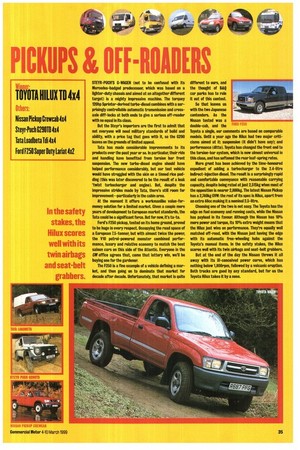PICKUPS & OFF-ROADERS
Page 37

If you've noticed an error in this article please click here to report it so we can fix it.
STEYR-PUGH'S 0-WAGEN (not to be confused with its Mercedes-badged predecessor, which was based on a lighter-duty chassis and aimed at an altogether different target) is a mighty impressive machine. The torquey 120hp Sprinter-derived turbo-diesel combines with a surprisingly controllable automatic transmission and crossaxle diff-locks at both ends to give a serious off-reader with no equal in its class.
But the Steyr's importers are the first to admit that not everyone will need military standards of build and ability, with a price tag that goes with it, so the 0290 leaves on the grounds of limited appeal.
Tata has made considerable improvements to its products over the past year or so. In particular, their ride and handling have benefited from torsion bar front suspension. The new turbo-diesel engine should have helped performance considerably, but our test vehicle would have struggled with the skin on a tinned rice pudding (this was later discovered to be the result of a leak 'twixt turbocharger and engine). But, despite the impressive strides made by Tata, there's still room for improvement—particularly in the cabin area.
At the moment it offers a workmanlike value-formoney solution for a limited market, Given a couple more years of development to European market standards, the Tata could be a significant force. But for now, it's ta-ta.
Ford's E250 pickup, tested on its home ground, proved to be huge in every respect. Occupying the road space of a European 7.5-tonner, but with almost twice the power, the V10 petrol-powered monster combined performance, luxury and relative economy to match the best saloon cars on this side of the Atlantic. Everyone in the CM office agrees that, come that lottery win, we'll be buying one for the gardener.
The F250 is a fine example of a vehicle defining a market, and then going on to dominate that market for decade after decade. Unfortunately, that market is quite different to ours, and the thought of MO car parks has to rule it out of this contest.
FORD F250
So that leaves us with the two Japanese contenders. As the Nissan tested was a double-cab, and the Toyota a single, our comments are based on comparable models. Until a year ago the Hilux had two major criticisms aimed at it: suspension (it didn't have any); and performance (ditto). Toyota has changed the front end to the torsion-bar system, which is now almost universal in this class, and has softened the rear leaf-spring rates.
More grunt has been achieved by the time-honoured expedient of adding a turbocharger to the 2.4-litre indirect-injection diesel. The result is a surprisingly rapid and comfortable conveyance with reasonable carrying capacity, despite being rated at just 2,51514 when most of the opposition is nearer 2,800kg. The latest Nissan Pickup has a 2,140kg GM: the rest of its spec is Hilux, apart from an extra 48cc making it a nominal 2.5-litre.
Choosing one of the two is not easy. The Toyota has the edge on fuel economy and running costs, while the Nissan has payload in its favour. Although the Nissan has 10% more power and torque, its 10% extra weight means that the Hilux just wins on performance. They're equally well matched off-road, with the Nissan just having the edge with its automatic free-wheeling hubs against the Toyota's manual items. In the safety stakes, the Hilux scores well with its twin airbags and seat-belt grabbers.
But at the end of the day the Nissan throws it all away with its III-conceived power curve, which has nothing below 1,800rpm, followed by a volcanic eruption. Both trucks are good by any standard, but for us the Toyota Hiles takes it by a nose.








































































































